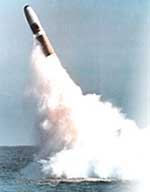 |

A FLEXIBLE DEFENSE
The Stockpile
As the nature of threats to the United States and the
world has evolved, our defense policy has changed from one based on
specific threats to one that can respond quickly to many kinds of potential
threats, including asymmetric threats. One part of our nation's capabilities-based
defense is our enduring nuclear stockpile—the country's supply of readily
available nuclear weapons.
U.S. nuclear strategy relies on a combination of aircraft-delivered
bombs and cruise missiles, intercontinental ballistic missiles, and submarine-launched
missiles.  This combination remains the strongest, most flexible, and most
survivable form of deterrence. Each type of warhead is designed to meet a
variety of military requirements, the constraints of the delivery vehicle,
and the conditions the weapons might experience during their entire life in
the stockpile. This combination remains the strongest, most flexible, and most
survivable form of deterrence. Each type of warhead is designed to meet a
variety of military requirements, the constraints of the delivery vehicle,
and the conditions the weapons might experience during their entire life in
the stockpile.
Deterrence has been the foundation of U.S. nuclear
strategy throughout the Cold War. We maintain a nuclear stockpile in order
to persuade enemies that they would have to pay the ultimate price for
attacking us. Since
the end of the Cold War, however, it has become clear that nuclear deterrence
by itself is not enough to prevent harm to the U.S. So, our country
is increasingly using conventional military capability to dissuade potential
adversaries. But nuclear weapons still remain an essential part of the
defense equation.
|

WHAT'S IN A STOCKPILE?

The stockpile, also called the nuclear arsenal, refers to a country's supply of readily available nuclear weapons. The term nuclear weapons refers to the explosive warheads and the bombs and missiles that can deliver them to enemy targets.
|
